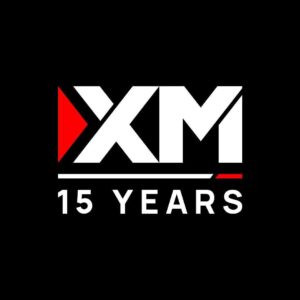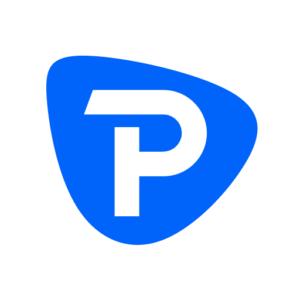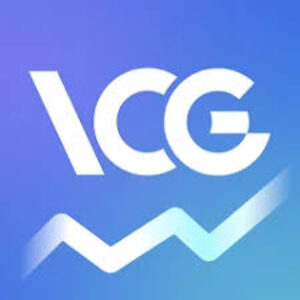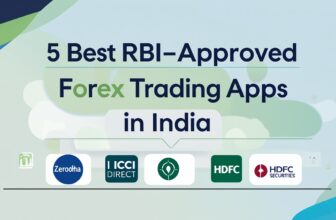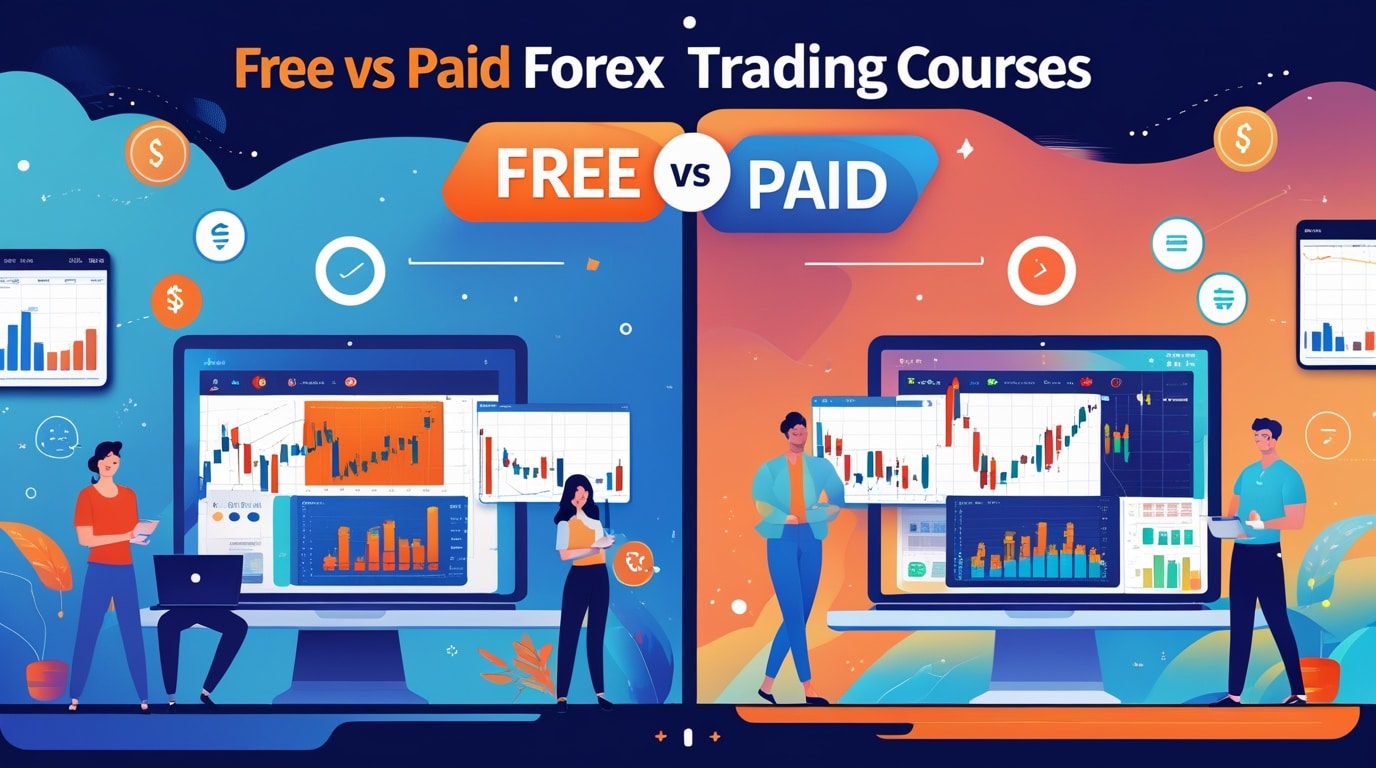
A forex trading course can be a valuable way to learn how to trade currencies, especially for beginners entering the complex world of FX markets. Course offerings range from completely free forex trading course materials – like YouTube tutorials, blogs and broker webinars – to comprehensive paid courses run by professional educators. Each approach has advantages and drawbacks. As investing legend Warren Buffett famously advises, “Invest in yourself as much as you can; you are your own biggest asset by far.”. In trading, investing in quality education (whether paid or free) is a key step toward success. This article compares free and paid forex trading courses, covering what each type typically includes and omits, with focus on instructor quality, certification, tools and community access, mentorship, structure, and the risk of misinformation. By the end, beginners will have practical advice for choosing the best forex trading course to fit their goals and budget.
What Is a Forex Trading Course?
A forex trading course is an educational program that teaches how the foreign exchange (FX) market works and how to trade currencies. These courses typically cover fundamental topics such as what currency pairs are, how exchange rates move, and common trading terminology (e.g. “pips” and “lots”). They also delve into market analysis and strategy: for example, most courses explain technical analysis (chart patterns and indicators) and fundamental analysis (economic news impact). Other core modules include risk management (setting stop-loss orders, position sizing) and trading psychology (controlling emotions). In short, a good course builds a beginner’s foundation from A–Z: what FX is, how to analyze markets, and how to plan and execute trades.
Course formats vary widely. A free forex trading course might be a series of blog articles, a YouTube playlist, or a self-paced tutorial (for instance, the popular “Babypips School of Pipsology”). These resources introduce concepts without cost and allow users to learn flexibly. In contrast, a paid course is usually more structured: it may come as a sequence of video modules, live webinars or workshops, and often includes interactive elements like quizzes or simulated trading. Paid programs frequently offer certificates of completion or accredited qualifications, whereas free courses rarely do. In either case, the goal is the same: impart the domain knowledge and technical skills needed to trade successfully. As trader-author Yvan Byeajee notes, “Reaching any goal in trading requires specific domain knowledge and technical skills”. A good forex course—whether free or paid—aims to deliver that knowledge in a logical sequence appropriate for beginners.
Free vs Paid Forex Trading Course: Pros and Cons
Beginners often start with free resources because they’re easily accessible. Free courses require no investment beyond your time, and many quality options exist online. However, free and paid courses differ markedly in content depth, support and structure. The table below summarizes key differences often noted by educators and traders:
| Feature | Free Forex Course | Paid Forex Course |
| Cost | $0 | $$$ (varies from modest to high) |
| Course Structure | Basic or unstructured | Comprehensive, step-by-step |
| Instructor Quality | Varies widely; may be hobbyists or volunteers | Often experienced professionals or trading educators |
| Support | Limited (self-study, online forums) | Extensive (live Q&A, mentor access) |
| Tools & Materials | Basic (free charts, general videos) | Advanced (premium charting, simulators, proprietary tools) |
| Certification | Rare or none | Often includes certificates or accredited credentials |
| Community | Public forums or none | Private student groups, forums, webinars |
| Updates | Infrequent or outdated | Usually up-to-date with market changes |
Table: Typical differences between free and paid forex trading courses.
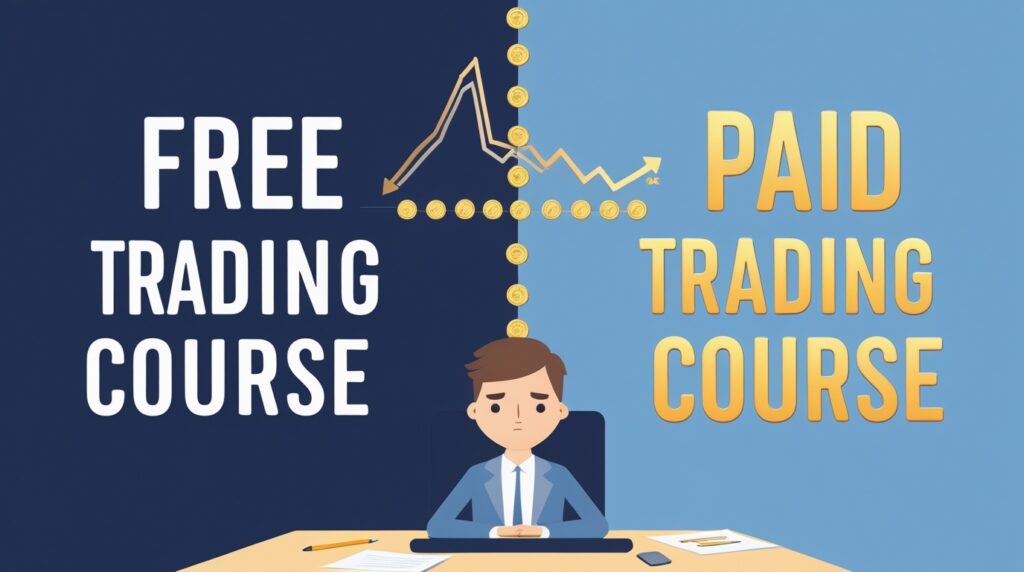
Each option has its own advantages and limitations:
- Free Forex Trading Course: The biggest advantage is no cost and immediate access. Free courses (for beginners) typically offer basic introductions. For example, many provide video tutorials, written guides on fundamental concepts, and access to community forums or blog comment sections for peer discussion. This can be a great way to learn the essentials without pressure. However, because these resources are often self-made, the quality and accuracy vary. They may lack depth (advanced strategies, real-time market commentary) and provide little or no personal support. Users must research content themselves; there’s a risk of encountering outdated or inaccurate information. Certification and official accreditation are usually absent, so a free course may not carry formal recognition. Instructors of free courses might be hobbyist traders or bloggers – while some are knowledgeable, others may have limited experience. As one guide advises, always “assess the qualifications and experience of the course instructors”, since “experienced traders with a proven track record… are better equipped to impart valuable insights”. Free courses also rarely offer mentorship or live coaching, meaning beginners miss out on tailored feedback.
- Paid Forex Trading Course: Paid programs tend to be more structured and polished. They often include a clear curriculum (modules on basics, technicals, strategy, etc.) and may offer live seminars or interactive webinars. Importantly, paid courses frequently feature experienced trainers or professional mentors who can answer questions and demonstrate live trading techniques. According to one expert training site, “if you’re looking for tailored one-to-one support and on-demand help, paid courses are the way to go.” This means you can get personalized feedback and quicker clarification of doubts, which free courses generally lack. Paid courses also typically bundle advanced tools: for example, access to premium charting software, trading simulators, or specialized indicators that help practice strategies in a safe environment. Many include graduation certificates, which can enhance your resume or credibility.
The downsides of paid courses are obvious: they cost money, and some can be very expensive. Price does not always guarantee quality; there are low-value paid programs on the market too, sometimes little better than free content. Beginners should beware of high-price scams or courses that promise quick riches. Always look for transparent reviews and sample lessons before buying. On the plus side, many paid educators understand this concern and offer refund policies or trial periods to reduce risk. Also note: you don’t have to pay a fortune to benefit – some reputable paid courses are quite affordable and even offer payment plans. The key is ensuring the course aligns with your skill level and learning style.
In summary, free courses gain by being costless and flexible but miss formal support, accreditation, and often have uneven quality. Paid courses gain structure, community, and expert guidance, but miss the affordability and require careful vetting for value.
What Free and Paid Courses Typically Include
To clarify further, here are some common components of each:
- Free Course Offerings: Video tutorials on basics, glossary of terms, blog articles (e.g. market analysis), community forums (Reddit, trading groups), basic charting tools (free platforms), and sometimes quizzes or slideshows. Many forex brokers and educators also publish free webinars or “masterclass” videos. These resources tend to focus on fundamental concepts: how the FX market works, simple trading examples, and foundational risk management.
- Paid Course Offerings: Structured lesson modules (often with progressive difficulty), live or recorded webinars by instructors, one-on-one or group coaching sessions, downloadable materials (e.g. strategy guides, checklists), trading simulators for practice, and advanced analysis training (pattern recognition, strategy backtesting). Paid packages often include access to an exclusive student community (private forum or chat) and ongoing support. For instance, one course may provide weekly live trade reviews or Q&A sessions, whereas a free course would not.
According to one trading education guide, free resources typically “provide video tutorials… market analysis articles… trading community forums… [and] basic charting tools”, whereas paid courses deliver “live trading sessions with expert instructors… step-by-step trading strategy courses… personal mentorship… professional-grade trading tools… [and] structured curriculum with assessments”. These lists highlight that paid courses generally cover a wider range of features geared toward immersive learning.
Key Features of a Forex Trading Course
Whether free or paid, some features are essential for an effective forex trading course. Beginners should look for:
- Clear Curriculum Structure: The course should outline exactly what topics will be covered and in what order. A logical progression (from basic to advanced) helps learning. Paid courses often excel here, but even free courses may organize lessons into “levels” or chapters. Avoid courses that just throw random videos or articles at you without sequence.
- Qualified Instructors: Check the background of the teacher or creator. An instructor with proven trading experience or educational credentials adds credibility. As the forex education guide emphasizes, courses taught by “experienced traders with a proven track record… are more likely to impart valuable insights”. In paid programs, these experts often provide personal anecdotes of success and failure to illustrate lessons. In free content, transparency about the instructor’s expertise varies, so do research (look for LinkedIn profiles, interviews, etc.).
- Certification or Accreditation: While not strictly necessary for success, official certification can indicate quality. Many paid courses offer a certificate of completion; some even partner with industry organizations (though forex is unregulated so certificates are not standardized). Free courses rarely provide certificates, so you miss that credential. If certification matters to you (e.g. for a résumé), that is a gain of paid courses to consider.
- Access to Tools and Data: See if the course provides access to trading platforms, charting software, or simulators. Paid courses often include demo accounts or proprietary tools to practice strategies without risk. For example, a course might include a licensed charting platform for students. Free courses, in contrast, expect you to find your own tools (though many free charting apps exist).
- Community and Mentorship: Learning is easier with peer support. Paid courses commonly include access to alumni groups, live chat rooms or mentor check-ins. Some even assign a mentor who reviews your trades. Free courses typically do not offer dedicated mentoring. You might rely on general forums or comment threads, which lack personal guidance. If ongoing support and networking are important to you, that is a clear advantage of many paid programs.
- Updated Content: Forex markets and regulations evolve, so up-to-date information is vital. Check when the course was last revised. Paid instructors often update their materials to reflect current market conditions. Free materials, unless maintained by a large organization, can become outdated. For instance, a strategy that worked in 2015 may not work well today; quality paid courses will address such changes, whereas a forgotten free tutorial might not.
- Risk of Misinformation: Because anyone can publish forex tips online, free courses carry some risk of flawed advice. Look for courses that cite reliable sources or industry best practices. Paid courses sometimes mitigate this by being accountable (they risk bad reviews if wrong). Always cross-check key concepts (e.g. margin trading rules, currency correlations) with reputable sites or official broker resources.
A concise way to compare support levels is from a study guide: free courses often have “basic” support, whereas paid ones aim for “extensive” support. In other words, if you need hand-holding, interactive coaching or real-time assistance, a paid course is more likely to provide it. As one professional academy guide notes, free materials can give “a quick fix of knowledge,” but “if you’re looking for tailored one-to-one support… paid courses are the way to go.”.
Choosing the Best Forex Trading Course for Beginners
There is no one-size-fits-all best forex trading course, but beginners can improve their chances by matching a course to their needs and budget. Here are practical tips:

- Start with Free Resources to Build Foundation: Before paying anything, use free courses or tutorials to learn the very basics and confirm your interest. Free materials are sufficient for understanding fundamental terms and simple strategies. They also help you gauge your learning style (video vs text) and commitment level.
- Vet Paid Courses Carefully: If you consider a paid course, research thoroughly. Read reviews on independent sites, not just testimonials on the provider’s page. Look for sample lessons or money-back guarantees. Check that the instructor is credible. Some paid courses offer free trial modules – use those to assess quality. Compare syllabus outlines: the best forex trading courses have clear, transparent curricula.
- Consider Certification If It Matters: If a certificate is important for you (for example, to add to a professional profile), look for courses affiliated with recognized financial education bodies. While forex is informal, some courses partner with trading academies or use gold-standard curriculums.
- Balance Theory and Practice: The best courses blend knowledge with practice. Ensure any course – free or paid – includes exercises like demo account trading, case studies or quizzes. Passive reading alone is not enough. Simulators and demo platforms (often included in paid packages) can be very helpful for hands-on learning.
- Check for Community and Updates: A good paid course usually has an active community (forum, group chat) and is updated regularly. If these are priorities, lean toward courses that emphasize them. If you choose a free course, supplement it by joining reputable trading communities (e.g. on Reddit or specialized forums) for questions.
- Mind the Scams: Always be cautious of courses that promise guaranteed profits or overly hyped results. Realistic courses stress risk and discipline. Look for neutral phrasing. Remember Buffett’s warning: “Risk comes from not knowing what you’re doing.”. If a course glosses over risk management or sells “secret signals,” it’s likely low quality.
- Invest in Yourself, But Incrementally: As the Buffett quote reminds us, knowledge is an investment. A practical approach is to start small: you might begin with free courses, then pay for one modestly-priced course to deepen your learning. Many learners find that combining resources works best (e.g. complement a paid core course with free YouTube videos on specific strategies).
Conclusion: Practical Advice for Beginners
In the end, both free and paid forex trading courses have roles in a beginner’s journey. Free courses give you a risk-free start, allowing you to learn core concepts with no financial outlay. Paid courses often provide depth, support, and structure that can significantly accelerate learning for committed students. The key is to know what you need: if you prefer self-study and just want the basics, a free course (or multiple free resources) might suffice initially. If you value step-by-step guidance, live mentorship, or certification, investing in a paid course may be worthwhile.
No matter what you choose, remember that learning to trade is a marathon, not a sprint. Use demo accounts to practice (many brokerages offer free practice platforms), and continuously test new knowledge on a small scale. As Buffett implied, education is a lifelong investment. Finally, combine any course study with discipline and risk management. If you stay patient, keep learning, and apply sound strategies, you’ll build the solid foundation needed for successful forex trading – even if that knowledge came from a mix of free and paid courses.
FAQ
What topics should a beginner expect in a forex trading course?
A good beginner’s forex course covers the fundamentals of currency trading. Expect modules on how the FX market works, key currency pairs, and trading terms (pips, lots, leverage, etc.). Courses usually include technical analysis (charts and indicators) and fundamental analysis (economic news), as well as risk management (setting stop-losses, managing trade size) and trading psychology. Many courses also teach order types, basic strategies, and how to use demo platforms safely. If a course includes these topics in an organized way, it’s covering the essentials for beginners.
Can free forex trading courses really help me learn to trade?
Yes – free courses can definitely help you start learning. High-quality resources like Babypips’ School of Pipsology, broker tutorials, and YouTube lessons cover the basics at no cost. They explain currency pairs, chart reading, and simple strategies clearly. However, free courses often lack personalized guidance or advanced tools, so you may need to combine multiple sources. For beginners, they are a great way to test the waters before deciding whether to invest in a paid program.
Is it worth paying for a forex trading course as a beginner?
It can be, depending on your goals. Paid courses usually offer structured modules, expert instructors, and community support that free resources don’t. If you prefer organized lessons, live coaching, or practice tools, a paid course can be valuable. Many also provide certificates. However, not all paid courses are high-quality, so check reviews and compare syllabi before enrolling. Paying more does not guarantee success—consistent practice on a demo account is essential.
What makes a forex trading course the 'best' for beginners?
The best beginner course matches your learning style and clearly covers foundational topics. Look for simple explanations, practical examples, and lessons on chart reading and risk management. Support tools such as mentorship, Q&A sessions, or community forums are helpful. The course should be updated regularly and offer demo trading opportunities. Ultimately, the best course is one that builds confidence to place your first demo trades and helps you progress steadily.
Do I need a certificate or accreditation to trade forex?
No, certification is not required to trade forex. The market is accessible without formal credentials. However, certificates from reputable courses can add credibility if you’re seeking opportunities in finance or want structured learning. They indicate that you completed a formal program, but actual trading skill comes from practice and discipline. Certificates are optional—focus on developing real trading competence.



